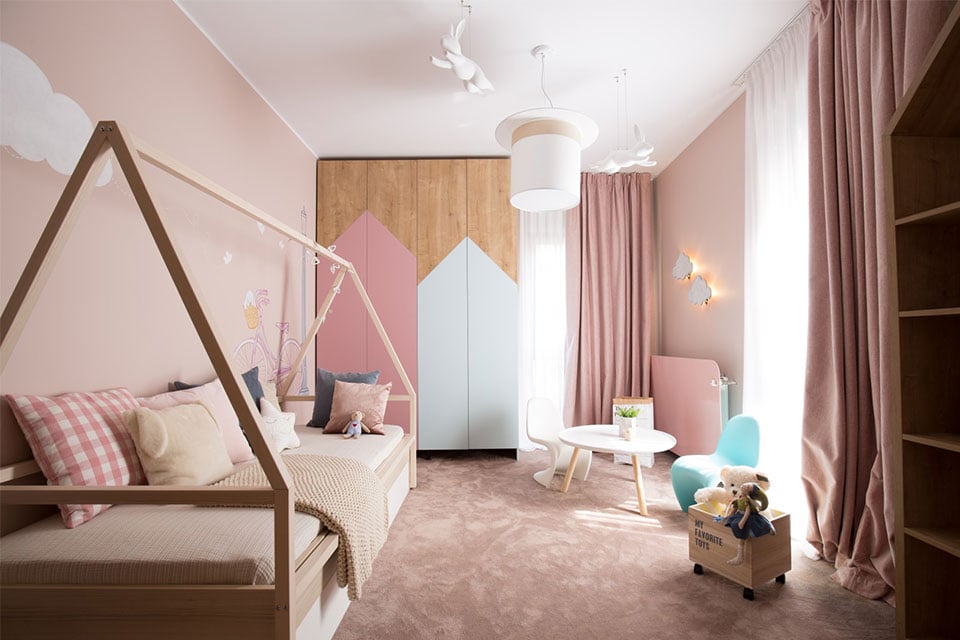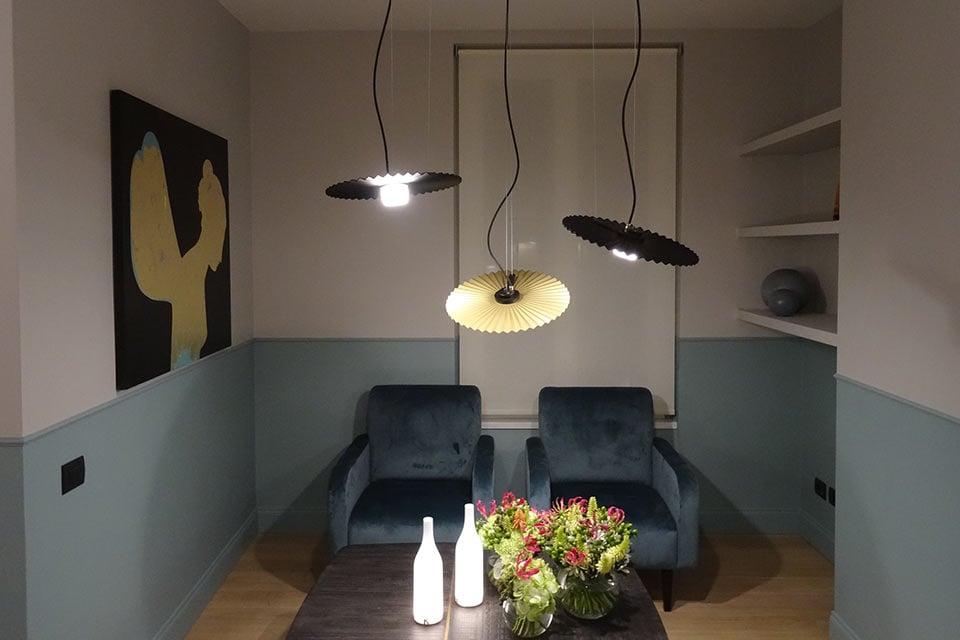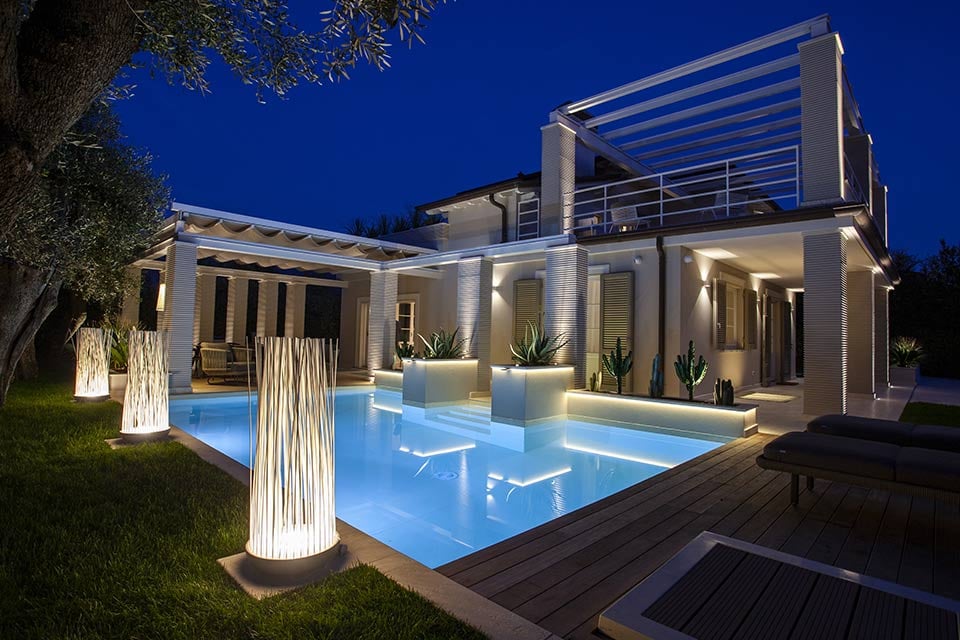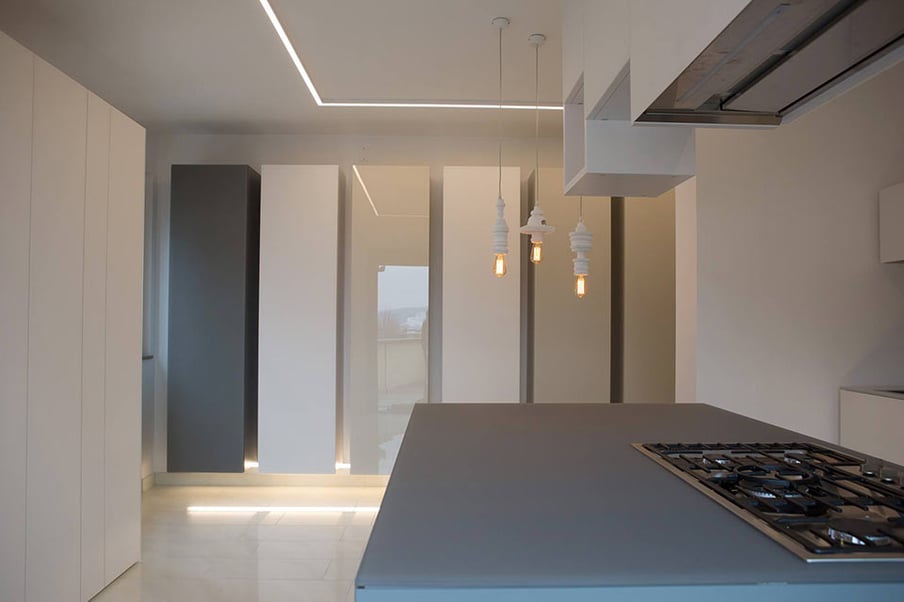Inserting adequate lighting is extremely important for a self-respecting lighting project. What makes the difference between a general project and a well-structured project is the strategic selection of the correct lighting installations for each environment, whether indoors or outdoors. In both cases, your project’s lights must be able to evoke suggestive atmospheres and irresistible charm.
In outdoor environments, light plays a particularly relevant role, as it welcomes your clients home every day and has the task of presenting their home and lifestyle to both neighbors and guests.
The installation of adequate lighting in outdoor areas that goes from the garden to the facade and, where provided, from the poolside to the terrace, greatly improves the quality of outdoor spaces, making them pleasant and comfortable at any time of the day and giving guests a first look at your client’s personal taste, which will determine the style of the indoor environment.
For you to perfectly realize your project, you need to know the difference between technical lighting and scenographic lighting. Let's analyze them both.
Differences between technical lighting and scenographic lighting
To properly illuminate any environment, you must be able to find the right compromise between technical lighting and scenographic lighting.
First, however, let's look at some examples that concern both the first and second type of lighting, to understand what we are talking about.

Wow
What is meant by technical lighting
Technical lighting takes on a specific term, namely lighting engineering: a technical-scientific discipline that deals with illuminating spaces and environments, both internal and external, using both sunlight and artificial light.
To create an artificial lighting project, it is necessary to know about lighting engineering, but it is not enough. For a lighting project to be complete, the optimal condition is interdisciplinary knowledge, including:
- The physiology and psychology of vision, which concern the luminous perception of the human eye, the ergonomics of lighting, and visual comfort
- Architecture and design, regarding the choice of light suitable for indoors or outdoors, for buildings, monuments, squares, gardens, and museums
- Electrical engineering, i.e., how electricity is used in lighting, the various types of lamps and systems
- The regulation on safety--emergency lighting--saving energy, and light pollution
Technical lighting, therefore, concerns the set of technical knowledge that you need to bring together in your artificial lighting project to ensure that it is in accordance with the law and functional for any environment you illuminate.

Ceraunavolta and Aprile
What is meant by scenographic lighting
Your lighting project is not only technical but also emotional. Having the ability to create a unique design with light, it creates powerful emotional effects in any environment, whether it is central, like the living room, or a passageway like the entrance, or intimate and warm like the bedroom.
For this reason, you must know how to integrate and manage scenographic lighting, which goes beyond the mere lighting system of a room and is also very important from a functional and design point of view.
Scenographic lighting can decorate through the use of light, enhancing the environment’s architecture, or highlight the peculiarities of the furnishings, creating plays on light and interesting shapes capable of bringing about different emotions depending on the context in which they are provided.
Therefore, light is not only understood here as the ability to illuminate a room but above all as the ability to customize an environment, strengthen its style, and create magical atmospheres using light.
It must be specified that technical lighting and scenographic lighting are both a part of the lighting engineering. It represents the ability to illuminate, respecting the technical and regulatory characteristics, but also to be able to give personality to the lighting project with designer lamps to create atmospheres capable of provoking suggestive emotions in every environment.
Here, technical lighting and scenographic lighting are two sides of the same coin, with a continuous and indissoluble relationship. Exactly as happens between brightness and contrast, these two types of lighting must be regulated one concerning the other, to be able to calibrate them in the best way to have exactly the desired lighting effect, both as regards the purely technical aspect and the scenographic effect.
Having clarified this, let's take a look at some advice for a balanced lighting design.
How to set up a project to best calibrate technical lighting and scenographic lighting
For your project to be exhaustive and satisfy your client, you must study all the spaces that you are going to illuminate and understand their identity.
For each space, your client will entrust a specific function and furnishings that follow the idea that they have in mind, that best represents them and makes them feel at ease. These are essential data for you because they indicate the type of atmosphere that best suits the use for whatever that space is intended.
From a technical lighting point of view, you calculate how many Lumens and Watts are needed to illuminate each environment; as far as scenographic lighting is concerned, you should be able to surprise your client with the right luminous choreography.
To give an example, a dining table can be used for various activities, such as eating, studying, reading, or simply enjoying a glass of wine with friends: a successful lighting project should always be able to adapt to different situations in a way selective to meet different needs.

Mek
For this example, you could use dimmable lamps or a combination of ceiling and wall lamps, or even ceiling lamps and floor lamps, so that your client can use ceiling lamps for activities that require a brighter light and take advantage of a warmer and less intense light for other activities that require soft lighting, such as reading.
The play on light that you foresee in your project will be able to apply and combine your technical and regulatory knowledge with your creativity, which will form combinations capable of restoring the exact emotional suggestion that the moment requires, adapting functionally to the various experiences they can have in that space.
An elementary general rule that you can follow to best calibrate technical lighting and scenographic lighting is to use three different light sources to create interesting contrasts and a particular atmosphere.

Gonzaga and Bacco
Basic generic lighting
To create perfect basic generic lighting, you can use lighting fixtures whose light can be varied, such as LED ceiling spotlights, which are particularly suitable for this purpose. If you know how to distribute them evenly throughout the room, these spotlights will ensure uniform lighting.
For example, if you want to illuminate a dining table and have a structure with ceilings approximately 2.60 meters high, you can use 2 LED spotlights every 5 m2: this corresponds to a light output of about 300 lux, which returns a chromatic spectrum equal to warm white.

Don't Touch
Indirect lighting and backlighting
The use of indirect light and backlighting in a room means hiding light installations in empty or invisible spaces: this very soft lighting creates a very suggestive atmosphere.
To create an atmospheric backlight, LED strips are ideal: being extremely versatile, they can be easily positioned behind furniture, under beds, inside showcases, and in any other space that you deem suitable.
Specific accent lighting
For the cherry on top of your lighting project, put accents in specific places that deserve selective lighting.
Although wall and floor lamps can fulfill this task, suspension lamps are particularly suitable for bringing the eye to specific furnishings or areas.
Depending on the size of the area to be illuminated, different types of lamps can be useful. For example, if you need to illuminate an open space, the right size between technical lighting and scenographic lighting will be even more decisive, as you will certainly need to combine different types of light through different types of lamps, using them so that the light can embrace all the spaces fluidly, without ever neglecting the emotional reactions that each lamp, or combinations of them, that you choose.

Mek
Calibrate technical lighting and scenographic lighting in the best way for your project's success
We have seen the substantial differences between technical lighting and scenographic lighting and how, even if in the first, calculations and regulations prevail and in the second, psychological and emotional aspects, the integration of both are two interrelational aspects that determine the difference between making light and illuminating.
For your projects, follow the guidelines analyzed in this article wisely, using both the most general and the most specific advice, such as the three different sources of light to be used and combined strategically. This will give every project a special touch; in addition, it will distinguish you from a standard lighting project, that is, the attention to the emotional side, an essential component in lighting, exactly as much as the technical aspect is, if not more.
Never forget that light recalls particular emotions, and if your project is able to give your clients beautiful, suggestive emotions, this will ensure that they can live in any space comfortably and always have a pleasant experience, a fundamental factor that translates into the full success of your project.



